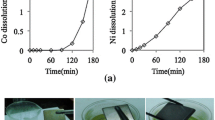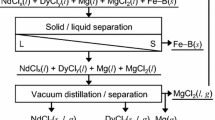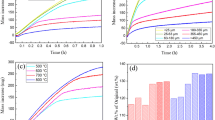Abstract
In this study, a hydrometallurgical process was evaluated for the recovery of Nd from a Nd-Fe-B magnet. Each leaching test was performed at the solid (weight) to liquid (volume) ratio of 1:50 and was mixed at 400 rpm at ambient temperature . The effects of 3 different acids (HCl, HNO3, and H2SO4) on the extraction of Nd were investigated and H2SO4 was found to be more effective than other acid solutions. Under the optimal conditions, pregnant leach solution was produced with H2SO4 for subsequent Nd precipitation testing . Each precipitation test was carried out using 100 mL of feed solution mixed at 600 rpm at 25 °C. NaOH and H2C2O4 were used for Nd precipitation . The highest Nd was precipitated as Nd2(C2O4)3·10H2O with C2H2O4 at 20 min.
Access provided by CONRICYT-eBooks. Download conference paper PDF
Similar content being viewed by others
Keywords
Introduction
The Rare Earth Elements (REEs) are described as a group of elements containing lanthanides with Sc and Y. The lanthanides are generally separated into two groups, light rare earth elements (LREEs—lanthanum through europium) and the heavier rare earth elements (HREEs—gadolinium through lutetium) [1]. The growing popularity and usage of wind turbines, electric and hybrid cars, HDDs, etc. has increased the demand of REEs. According to the medium-term criticality matrix from the U.S. Department of Energy (DoE), the five most critical REEs are neodymium (Nd), europium (Eu), terbium (Tb), dysprosium (Dy), and yttrium (Y) [2]. The European Commission considers the LREEs and HREEs as the most critical raw materials groups, with the highest supply risk. China has 95% of mine production of all REEs [3]. Current predictions indicate that the current production of Nd and Dy will not be sufficient for the projected demand in near future. The demand of Nd and Dy in 2020 is expected to increase and the shortage of Nd and Dy is projected to be 30 and 49% when the base year is 2015 [4]. Recycling of Nd containing scraps could be one of the potential options to minimize this risk. For Nd, there are two main sources for recycling : magnet manufacturing wastes and magnet scraps. Up to 25% of REEs (mostly Nd) can be lost during permanent magnet manufacturing process (sintering , cutting/polishing, magnetizing, etc.) as waste [5]. NdFeB magnets are composed of 30–40% REEs (15–30% of which is Nd), 50–70% Fe and 1% B. The composition can be changed due to required operating conditions [2].
Hydrometallurgical methods for NdFeB recycling typically starts with a leaching step. The leaching efficiency can be increased by grinding with NaOH followed by roasting at 500 °C. The grinding and roasting also provide selective leaching of REEs, however they increase the costs of the total process [6]. The consumption of acid solution is decreased with the roasting step, but total process duration can be reached up to 15 h. Solvent extraction (SX) is used for both removal of transition metals and production of high purity REE solution. REEs can be precipitated from their solutions with oxalic acid. The usage of oxalic acid depends on the amount of Nd in the solutions [7] and the impurity levels. In a direct leaching study, 3 M HCl solution was used at 110 °C for 6 h. The concentration of oxalic acid used for precipitation was 0.2 mol/L. After filtration , high purity neodymium oxalate hydrate was obtained as final product [8].
In this study, a cheap and fast process was evaluated. Stoichiometric amounts of three different acids (HCl, HNO3, and H2SO4) were used for the leaching of Nd-Fe-B hard magnetic material. Tests were carried out by varying the leaching time and acid concentrations to determine the optimum conditions. Sodium hydroxide and oxalic acid were used as precipitation agents.
Experimental
Materials
The raw materials used as the Nd-source were obtained from hard magnets that were demounted from end-of-life hard disk drives. The chemicals used in this study were; NaOH (97 wt%), H2C2O4 (99 wt%), HCl solution (37% wt%), HNO3 solution (55% wt%), and H2SO4 solution (97% wt%) obtained from Merck.
Leaching Procedure
The magnet scraps were demagnetized at 300 °C, then ground in a ball mill and sieved under 100 microns. In the first series of leaching experiments, the effects of three different acids (HCl, HNO3, and H2SO4) on the leachability of raw materials were investigated. Each leaching test was conducted at the solid (weight) to liquid (volume) ratio of 1:50 with 2 g of sample and 100 mL of 0.147 M acid solution mixed at 400 rpm at ambient temperature . In the second test series, after determining the better acid type, the effects of acid concentration and leaching time were studied. The acid concentrations were selected where chosen to target solutions pH’s of about 0.00, 0.15, and 0.45 and the leaching durations were selected as 15, 30, and 60 min; all other operating conditions were unchanged. The effects of the controlled parameters were investigated by the 3-level, 2-factor Taguchi experimental design method. Minitab 17 software was used to optimize the leaching parameters.
Precipitation
The precipitation experiments were carried on pregnant leach liquor , which was produced under the optimal leaching conditions. The experiments were performed at room temperature , for a 100 mL of solution with a stirring rate of 600 rpm. The amount of the reagents used was 0.5 g. The effectiveness of NaOH and C2H2O4 and the precipitation duration (10, 20 min, and 18 h) were investigated. Vacuum filtration was applied for solid-liquid separation and filter papers with precipitates were dried in an oven at 105 °C for 24 h.
Characterization
Particle size analysis was carried out with a Malvern, Master Sizer Hydro 3300. The phase analysis of the feed samples and solid products were carried out by X-ray diffractometer (Rigaku D/Max 2200/PC). Elemental analysis of samples was carried out by inductively coupled plasma—mass spectrometry (ICP–MS Agilent Tech. 7700 Series) for Nd and inductively coupled plasma—optical emission spectrometry (ICP–OES PerkinElmer Optima 2100DV) for Fe and B. Elemental analysis for solutions was carried out by only ICP–MS.
Results and Discussion
From the XRD analysis of the raw material, the main phase was detected as Nd2Fe14B. The chemical composition of the raw materials was 65.2% Fe, 25.1% Nd, and 1.0% B. In the first leaching series, where the leaching duration was selected as 3 h, the amount of Nd dissolved in the solutions (Nd-mass) are shown in Fig. 1. The highest Nd-mass was obtained in H2SO4 solution as 162.35 mg. During leaching of head material with H2SO4, the temperature of the solution was increased due to exothermic behavior of the reaction; this is thought to be the reason H2SO4 gave the highest dissolution of Nd. During the leaching with H2SO4, in the first 60 min, almost all the solid was dissolved. Due to this observation, one more test was carried out under the same conditions.
In the second series of leaching experiments, diluted H2SO4 solutions were used. Results are shown in Fig. 2, which suggests that the extraction of Nd is slightly increased with increasing the leaching time. While no significant differences were observed in the Nd-mass by changing in the acid concentrations.
The interaction between the factors is given in Fig. 3. The experiments with 30 min of leaching duration has similar Nd concentration for each pH values. The highest Nd-mass in 30 min leaching duration was obtained at 0.45 pH. The solution with less acid concentration is feasible from an economic and environmental perspective.
In the precipitation experiments with NaOH, the amount of precipitate was not enough for XRD . The amount of precipitated Nd at different durations is given in Fig. 4. The XRD result of participate obtained by C2H2O4 is shown in Fig. 5. The raw data was analyzed by HighScore X’pert Plus and the highest peaks were belonged to Nd2(C2O4)3·10H2O.
Conclusion
The H2SO4 solution was determined as the most suitable acid for leaching of NdFeB scrap magnets . The optimum leaching conditions were determined as 30 min of leaching duration and 34.1 g/L 98% w/w H2SO4. The highest amount of Nd precipitated from 100 mL of leach solution was with 0.5 g C2H2O4 at 20 min. Further study is required to evaluate the calcination time and temperature for the production of neodymium oxide (Nd2O3) from neodymium oxalate hydrate (Nd2(C2O4)3·10H2O).
References
Humphries M (2013) Rare earth elements: the global supply chain: Congressional Research Service Washington, DC
Binnemans K, Jones PT, Blanpain B, Van Gerven T, Yang Y, Walton A, Buchert M (2013) Recycling of rare earths: a critical review. J Clean Prod 51:1–22
Deloitte Sustainability BGS, Bureau de Recherches Geologiques et Minieres, Netherlands Organisation for Applied Scientific Research (2017) Study on the review of the list of critical raw materials. Brussels
Alonso E, Sherman AM, Wallington TJ, Everson MP, Field FR, Roth R, Kirchain RE (2012) Evaluating rare earth element availability: a case with revolutionary demand from clean technologies. Environ Sci Technol 46(6):3406–3414
Miura K, Itoh M, Machida K-I (2008) Extraction and recovery characteristics of Fe element from Nd–Fe–B sintered magnet powder scrap by carbonylation. J Alloy Compd 466(1–2):228–232
Yoon H-S, Kim C-J, Chung KW, Jeon S, Park I, Yoo K, Jha MK (2015) The effect of grinding and roasting conditions on the selective leaching of Nd and Dy from NdFeB magnet scraps. Metals 5(3):1306–1314
Vander Hoogerstraete T, Blanpain B, Van Gerven T, Binnemans K (2014) From NdFeB magnets towards the rare-earth oxides: a recycling process consuming only oxalic acid. RSC Advances 4(109):64099–64111
Itakura T, Sasai R, Itoh H (2006) Resource recovery from Nd–Fe–B sintered magnet by hydrothermal treatment. J Alloy Compd 408:1382–1385
Author information
Authors and Affiliations
Corresponding author
Editor information
Editors and Affiliations
Rights and permissions
Copyright information
© 2018 The Minerals, Metals & Materials Society
About this paper
Cite this paper
Güneş, H., Obuz, H.E., Oğur, E., Çapraz, F., Alkan, M. (2018). Rare-Earth Elements Recovery from Nd-Fe-B Hard Magnets by Hydrometallurgical Processes. In: Davis, B., et al. Extraction 2018. The Minerals, Metals & Materials Series. Springer, Cham. https://doi.org/10.1007/978-3-319-95022-8_239
Download citation
DOI: https://doi.org/10.1007/978-3-319-95022-8_239
Published:
Publisher Name: Springer, Cham
Print ISBN: 978-3-319-95021-1
Online ISBN: 978-3-319-95022-8
eBook Packages: Chemistry and Materials ScienceChemistry and Material Science (R0)









